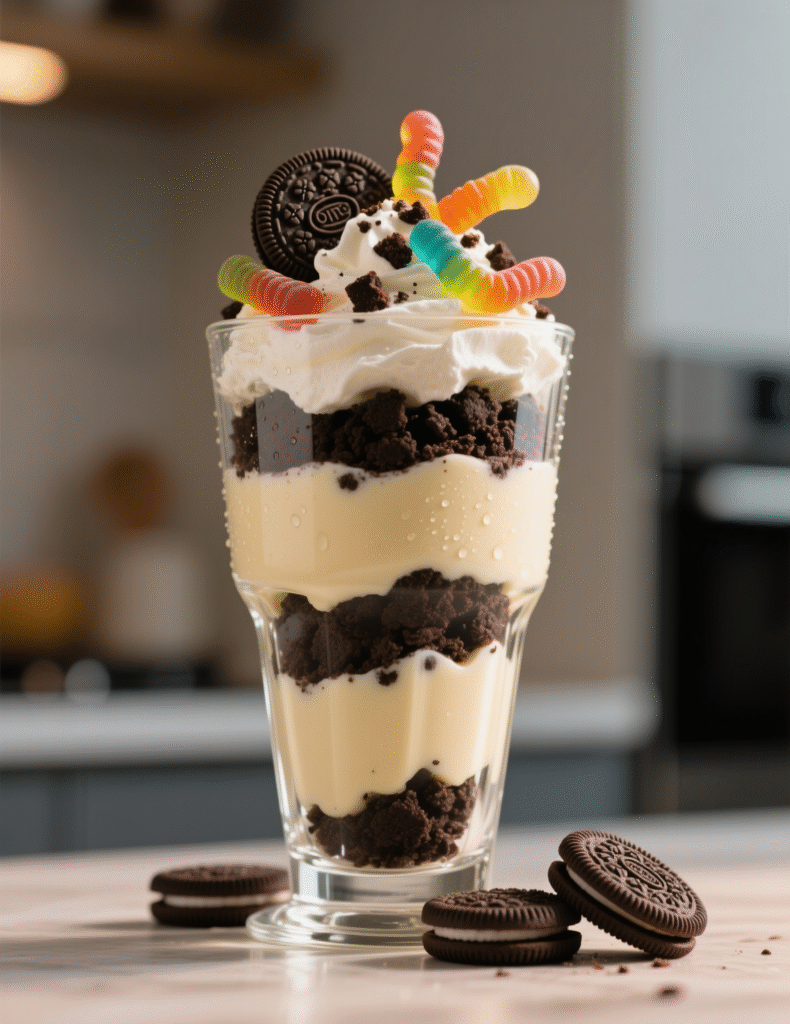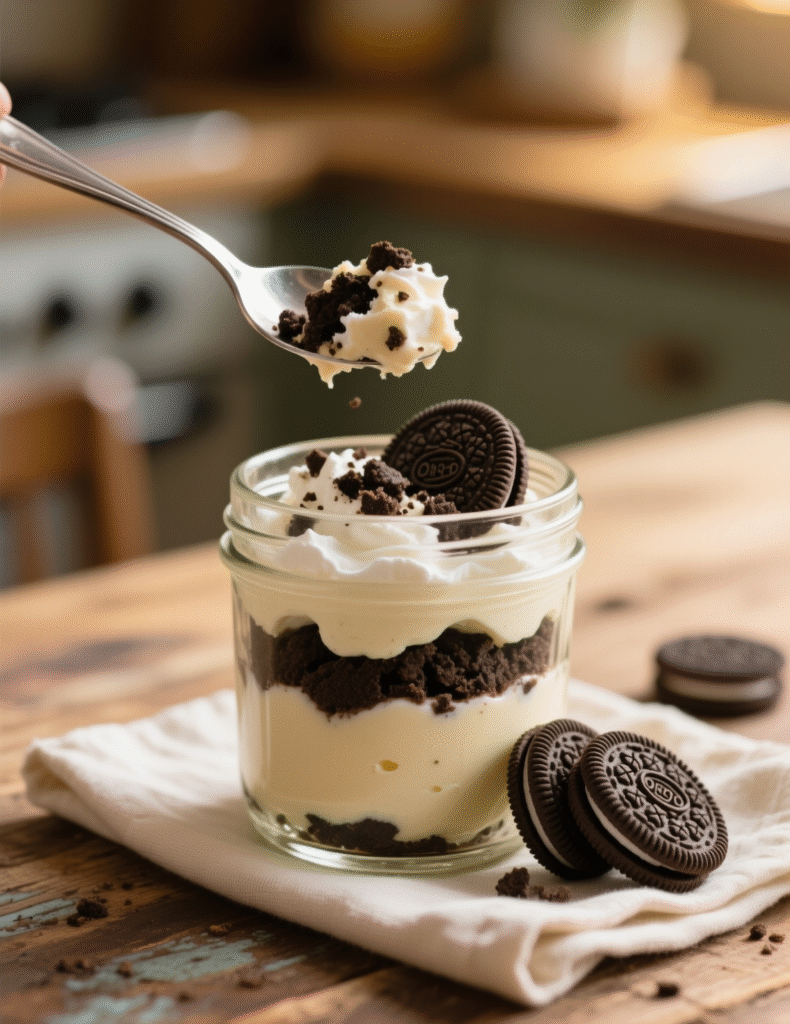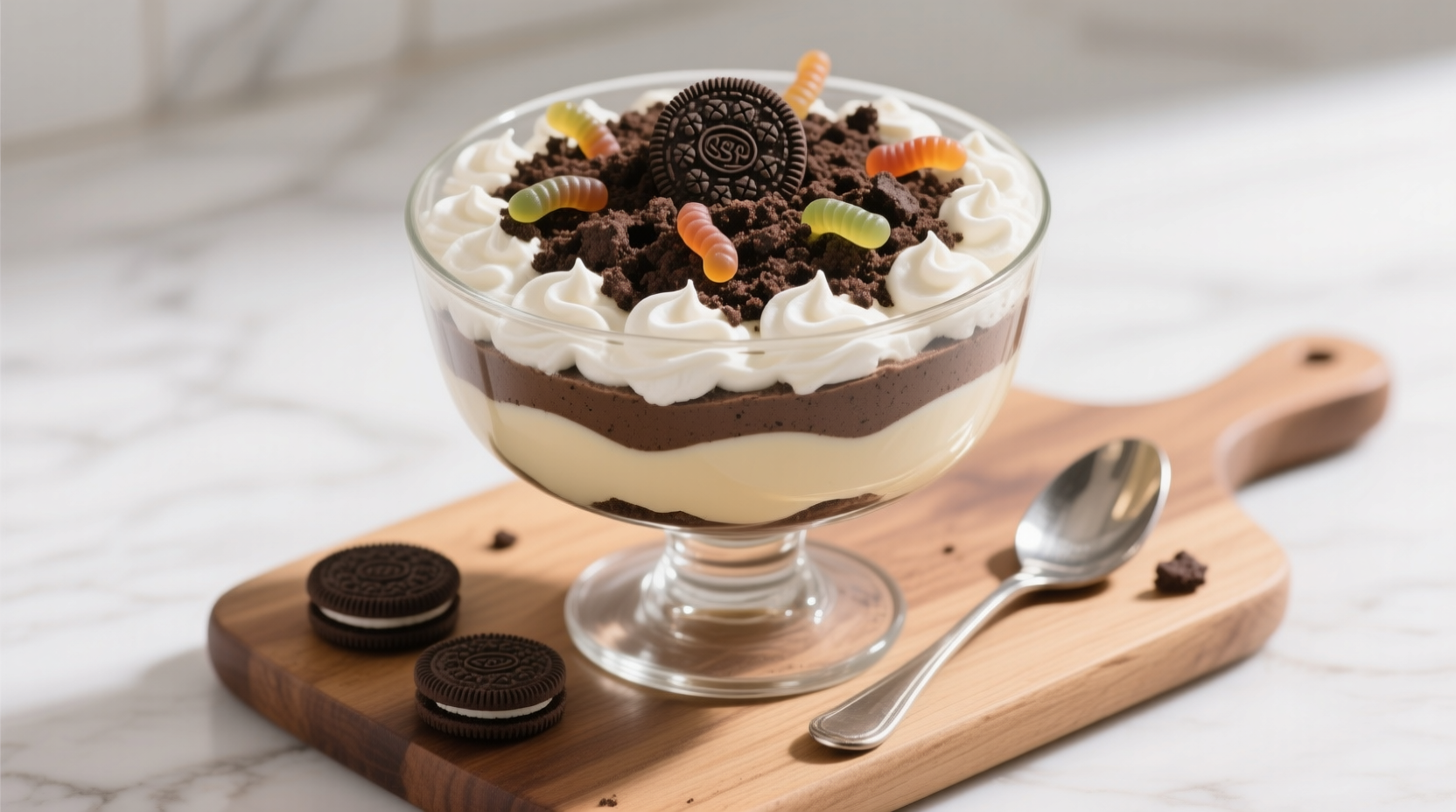It’s strange, isn’t it? Some desserts fade out of fashion, while others refuse to leave the table. Oreo Dirt Dessert belongs to the latter camp, holding its ground for decades in potlucks, birthday parties, and family gatherings. This isn’t just a kid’s treat anymore. When crafted right, it’s a textural masterclass—crunch meeting cream in a way even fine pastry chefs can’t easily replicate. And yes, if you think it’s “just crushed Oreos and pudding,” then you’ve only seen the quick version, not the professional-level build that has bakers whispering about ratios like it’s a state secret.
The Real Anatomy of Oreo Dirt Dessert
Strip it down, and you’ve got three structural players. The crumb layer (Oreo cookies), the cream layer (pudding + cream cheese + whipped topping), and the hidden architecture—how these layers are stacked, compressed, and chilled. Professionals know this dessert doesn’t succeed by sugar alone. The interplay between moisture retention and crunch timing is everything. Too early, and the Oreo layer loses its grit. Too late, and the cream won’t meld into that silky-dirt texture we’re all chasing.
A common pitfall: over-processing the Oreos until they’re dust. Yes, dust sounds fine for aesthetics, but texture is king. Leave in some rougher bits. Those jagged edges catch cream and release it differently in each bite, creating micro-contrasts you actually taste.
Ingredient Selection – More Science Than Shopping
Not all Oreos are equal for this. Standard Oreos hold up best; Double Stuf releases too much fat, which can make the cream layer greasy over time. Store-brand chocolate sandwich cookies? They work in a pinch, but you’ll lose some of the cocoa intensity that plays off the sweet cream.
For the pudding, instant pudding is non-negotiable if you’re going for the signature light texture. Professionals often use French vanilla or white chocolate pudding over standard vanilla—it creates more complexity in the cream without overpowering the Oreo base. And the cream cheese? This isn’t the place for low-fat substitutions. Fat equals mouthfeel, and mouthfeel is half the dessert’s charm.
Building Layers Like an Architect
Think of the dessert dish as a vertical playground. The first Oreo layer needs to be compacted slightly, but not so much that it forms a hard shell. That light press keeps the cream layer from sinking too far, which preserves the defined strata when you serve it.
The cream mixture is where pros win or lose. Blending cream cheese with powdered sugar before adding pudding ensures no lumps—lumps are the enemy. Fold in whipped topping slowly. The moment you whip it too aggressively, you lose air volume, and the cream becomes dense rather than cloud-like.
The final Oreo topping? Sprinkle generously, but don’t just dump. Controlled scatter creates visual interest and prevents the layer from clumping in one corner after refrigeration.

Temperature Control – The Quiet Player
An often-ignored truth: Oreo Dirt Dessert improves after resting in the fridge for 6–8 hours. The Oreo crumbs at the base soften just enough, while the top layer retains its crunch. Refrigeration also allows the pudding’s starches to fully set, giving the cream its characteristic firmness without turning rubbery.
But avoid freezing. The water in pudding will form ice crystals, breaking the emulsion when thawed. The result is a grainy cream that no amount of wishful thinking will save.
Professional Variations Worth Knowing
In upscale catering, I’ve seen Oreo Dirt Dessert presented in verrines with micro-mint leaves and chocolate curls. The principle remains the same, but with precision plating. Another twist: swapping half the Oreo crumbs for chocolate wafer cookies to deepen the cocoa note. Some pastry chefs mix in a whisper of espresso powder into the cream layer—it doesn’t taste like coffee, just richer chocolate.
Fruit inclusions, like raspberries or strawberries, are controversial. The moisture they release can break the delicate crunch-cream balance unless you add them fresh just before serving.
Portioning for Impact
When serving in large dishes, the first slice is always a mess. This is why many pros prefer pre-portioned cups. Clear cups showcase the distinct layers, and portion control helps maintain that visual appeal through the entire event. In plated service, a neat square cut from a chilled pan can be finished with a drizzle of chocolate ganache for a more formal look.
Shelf Life and Storage Insights
This dessert holds beautifully for up to 3 days in the refrigerator. After that, the Oreos lose too much structure, and the cream can start to weep liquid. To delay this, keep it covered tightly to prevent moisture migration from fridge humidity. If you’re making for an event, assemble the night before, not earlier.
Common Misconceptions
Some people believe this dessert is “just for kids.” That’s like saying crème brûlée is “just custard.” The balance of fat, sugar, and texture is deceptively sophisticated. Another misconception: more Oreos equals better flavor. Overloading crumbs creates dryness between layers, breaking the cream’s flow across the palate.
The Full Professional Recipe
Ingredients
- 36 standard Oreo cookies
- 8 oz full-fat cream cheese, softened
- 1/2 cup powdered sugar
- 2 packages (3.4 oz each) instant French vanilla pudding mix
- 3 1/2 cups cold whole milk
- 12 oz whipped topping (thawed)
- Optional: chocolate curls, mint leaves for garnish
Method
- Pulse Oreos in a food processor until coarse crumbs form. Reserve 1/3 for topping.
- In a mixing bowl, beat cream cheese with powdered sugar until smooth.
- In another bowl, whisk pudding mix with milk until thickened, about 2 minutes.
- Fold pudding into cream cheese mixture.
- Gently fold whipped topping into the mix until combined.
- In a 9×13 dish, layer half the crumbs, followed by half the cream mixture.
- Repeat layers. Finish with reserved crumbs.
- Cover and chill for 6–8 hours before serving.
Why This Recipe Works at Every Level
This version controls moisture, optimizes texture, and enhances flavor complexity without straying far from the nostalgic roots. The fat content in the cream cheese and whipped topping ensures mouth-coating creaminess, while the Oreo layer delivers a slow-releasing crunch. By avoiding over-processing and respecting refrigeration time, the result is a dessert that feels indulgent without being heavy.

Key Takeaways for Professionals
Respect texture timing—don’t rush the chill. Control crumb size for maximum mouthfeel. Avoid overloading sweetness; balance is key. Understand the interplay between fat, starch, and sugar. And never underestimate presentation, even for a “casual” dessert.
If done well, Oreo Dirt Dessert isn’t just a crowd-pleaser. It’s a reminder that even the simplest ideas, when executed with professional attention, can compete with high-end patisserie on pure satisfaction.
FAQs
How long should Oreo Dirt Dessert chill before serving?
At least 6–8 hours in the fridge for best texture and flavor.
Can I use Double Stuf Oreos for this recipe?
You can, but the extra cream may make the dessert a bit greasy.
What’s the best pudding flavor for Oreo Dirt Dessert?
French vanilla or white chocolate pudding gives the richest taste.
Can I freeze Oreo Dirt Dessert?
No, freezing creates ice crystals that ruin the cream texture.
How long does Oreo Dirt Dessert last in the fridge?
It stays fresh for up to 3 days when tightly covered.
Can I make this dessert in individual cups?
Yes, clear cups show off the layers and make serving cleaner.
Is it okay to use store-brand sandwich cookies?
They work, but you might lose some cocoa richness compared to Oreos.
Can I add fruit to Oreo Dirt Dessert?
Yes, but add fresh fruit right before serving to avoid sogginess.
Why are my Oreo crumbs too soft?
They may have been processed too fine or absorbed too much moisture.
Can I make it a day before an event?
Yes, in fact, making it the night before improves flavor and texture.

Mariana is a passionate home cook who creates delicious, easy-to-follow recipes for busy people. From energizing breakfasts to satisfying dinners and indulgent desserts, her dishes are designed to fuel both your body and hustle.
When she’s not in the kitchen, she’s exploring new flavors and dreaming up her next recipe to share with the Foodie Hustle community.

